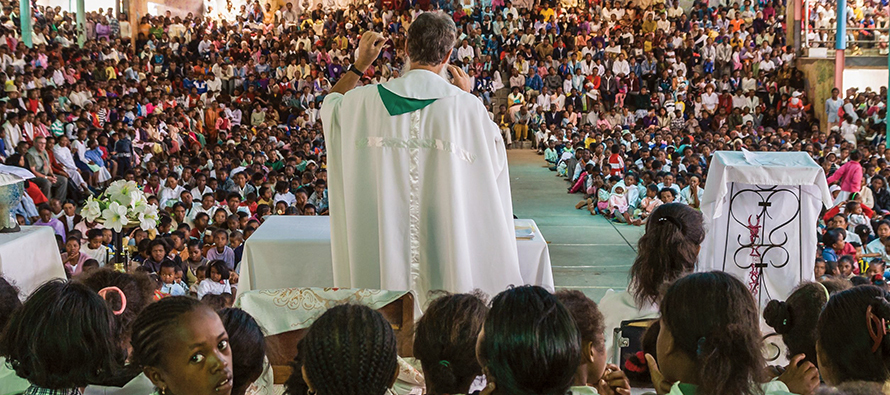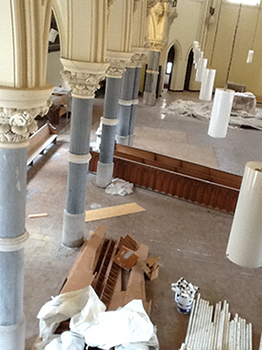Why are there parishes?

THE NECESSITY for established, well-defined parish boundaries was identified back at the Council of Trent (1545-1563) as a way to protect pastors and their communities from the harm that evolved from uncertain lines of authority and property. The original trouble was grounded in the feudal system: In earlier times the church was by no means separate from the state, as it is in most countries today. The notion of a parish with canonically (that is, by church law) protected rights and responsibilities serves to clarify what people “get”—and have a right to—when they join up.
Most parish boundaries are geographically defined, but they can also be designated by language, rite, ethnicity, or other elements that serve the community. There’s also a military diocese that encompasses U.S. servicepeople wherever they may be, creating parishes anywhere armed forces personnel are serving. Rites in communion with Rome, like Maronites, Melkites, Ukrainians, and others, establish parishes defined less by geography than by the particular liturgy customary for those communities.
What is a parish?
As a Catholic you may worship freely in any of these parishes or all of them if you wish. But there are advantages to registering with a particular parish—whether or not you live inside its technical boundaries—that are worth considering. A parish is defined by four basic elements. First, it stands to serve a certain segment of the People of God. Second, it’s administered by a priest specifically charged with its sacramental care. Third, a parish is governed by church law that outlines reciprocal rights and duties of pastor and parishioners. Finally, a parish is a suitable site guaranteed to contain all that’s necessary for the Catholic spiritual life: Eucharistic equipment, baptismal font, confessional, sometimes a cemetery, and a place for storing sacramental records. Above all, it is a spiritual haven and source of many important memories (see sidebar article below).
Those who register with a particular parish will have full access to all that’s necessary for Catholic identity. Get on the books. It makes your sacramental life easier!
Most parish boundaries are geographically defined, but they can also be designated by language, rite, ethnicity, or other elements that serve the community. There’s also a military diocese that encompasses U.S. servicepeople wherever they may be, creating parishes anywhere armed forces personnel are serving. Rites in communion with Rome, like Maronites, Melkites, Ukrainians, and others, establish parishes defined less by geography than by the particular liturgy customary for those communities.
What is a parish?
As a Catholic you may worship freely in any of these parishes or all of them if you wish. But there are advantages to registering with a particular parish—whether or not you live inside its technical boundaries—that are worth considering. A parish is defined by four basic elements. First, it stands to serve a certain segment of the People of God. Second, it’s administered by a priest specifically charged with its sacramental care. Third, a parish is governed by church law that outlines reciprocal rights and duties of pastor and parishioners. Finally, a parish is a suitable site guaranteed to contain all that’s necessary for the Catholic spiritual life: Eucharistic equipment, baptismal font, confessional, sometimes a cemetery, and a place for storing sacramental records. Above all, it is a spiritual haven and source of many important memories (see sidebar article below).
Those who register with a particular parish will have full access to all that’s necessary for Catholic identity. Get on the books. It makes your sacramental life easier!
 Saying good-bye to St. James Saying good-bye to St. Jamesby Sidney Nurnberger A CHURCH is not only a building for ritual. It is also a second home and a sanctuary. It is a place that becomes a haven and a recognized landmark in a neighborhood. When you have to leave that place, even for a short amount of time, it can be disheartening. When something like that is taken away forever, it can be devastating. That is what happened to my family and me when demolition began on St. James Church on 29th and Wabash Avenues in Chicago. The reasons for the demolition include changes in the neighborhood and the effects of a 1972 fire, but it did not hit me that they were actually going to take down the church until I saw the massive 5,000-pound bell removed from the tower along with the other 20 bells to be put into storage—bells Archbishop Patrick Feehan had consecrated in 1895. Designed by the architect Patrick C. Keely, who also designed Chicago’s Holy Name Cathedral, the church was dedicated on May 24, 1880. Since then St. James became a source of memories for hundreds of Catholics over the decades. I made my First Communion and my First Reconciliation—two very important events in my life—at St. James. Perhaps having two architects as parents and living in Chicago, which is home to a number of historic churches, added to my deep sadness when I learned St. James would be torn down. A place of worship should be cherished because so many people have prayed there. That alone makes it a sacred place, a place of peace, a place that deserves extra respect and protection. Sidney Nurnberger, a graduate of St. Ignatius College Prep in Chicago, is currently a student at Loyola University in New Orleans. |
Tags
Related
- What Catholics believe about the Eucharist
- How Jesus embraced his call
- Prayer: Our never-ending conversation with God
- What the church is teaching—and learning—about the sin of racism
- Church defined: Jesus calls; we respond
- A Creed to believe in
- On whose authority?
- Ten great things about being Catholic
- Following Jesus: Be ready for some surprises
- Enter into the divine Read More
Most Viewed
- Find your spirituality type quiz
- FAQs: Frequently asked questions about vocations
- Celibacy quiz: Can you live a celibate life?
- Resources for older discerners or those with physical and developmental differences
- About Vocation Network and VISION Guide


 Alice L. Camille, M. Div. is the author of Listening to God’s Word (Orbis Books). For more titles, please visit
Alice L. Camille, M. Div. is the author of Listening to God’s Word (Orbis Books). For more titles, please visit